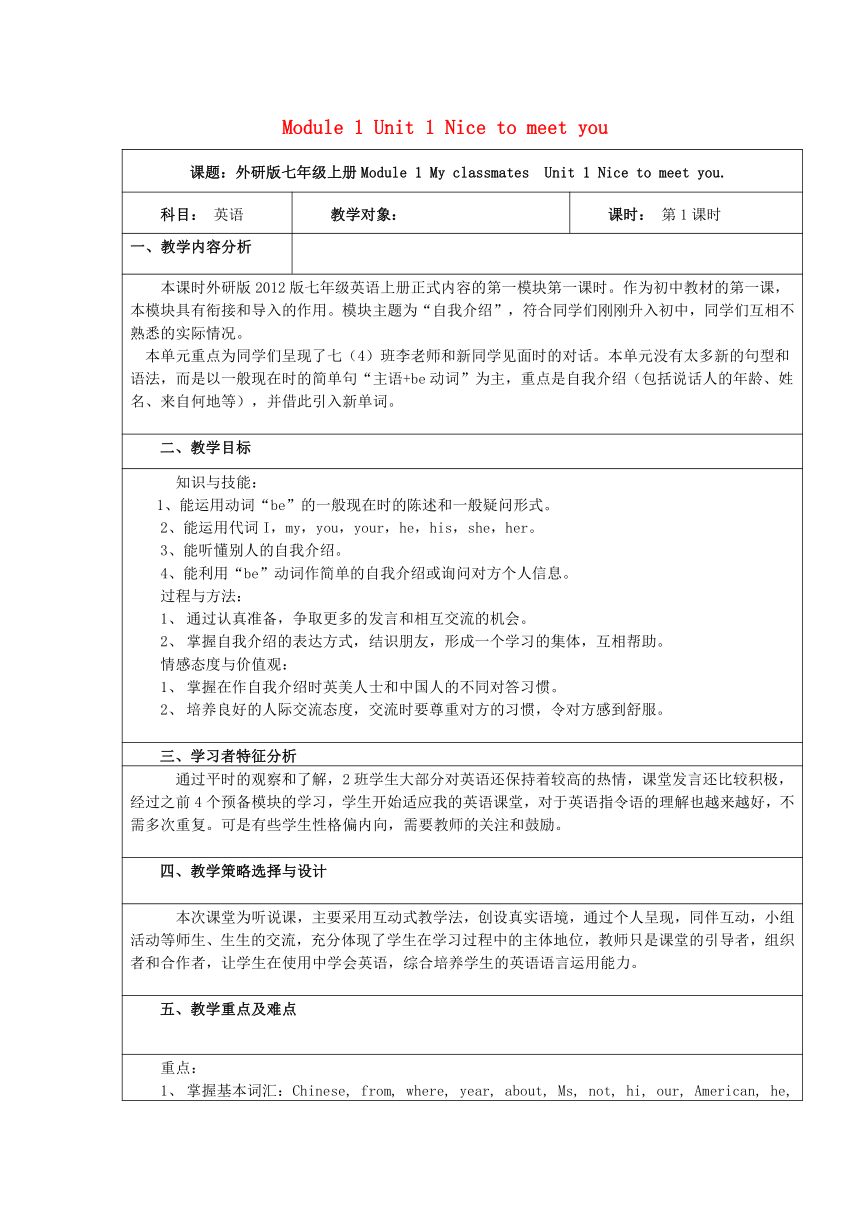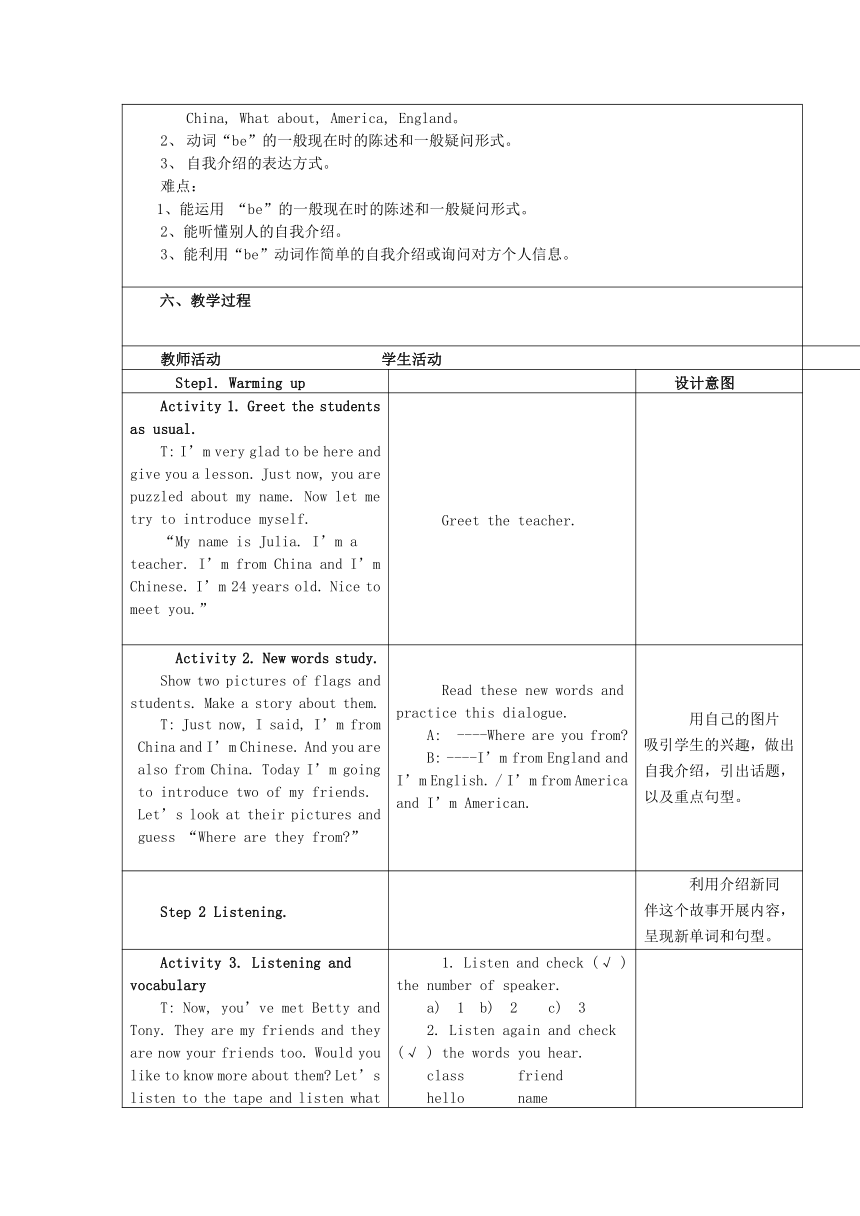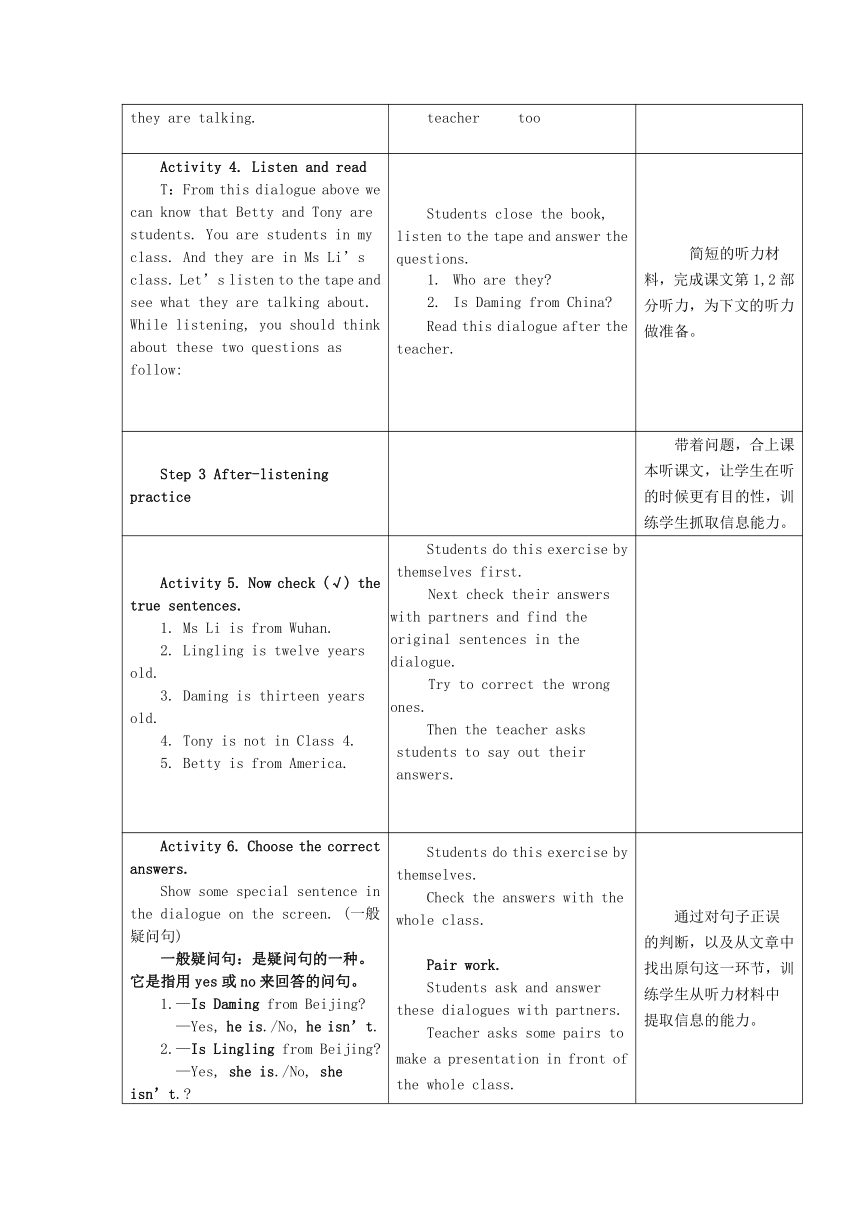七年级英语上册 Module 1 Unit 1 Nice to meet you教学设计 (新版)外研版
文档属性
| 名称 | 七年级英语上册 Module 1 Unit 1 Nice to meet you教学设计 (新版)外研版 |  | |
| 格式 | zip | ||
| 文件大小 | 26.8KB | ||
| 资源类型 | 教案 | ||
| 版本资源 | 外研版 | ||
| 科目 | 英语 | ||
| 更新时间 | 2014-10-15 20:02:36 | ||
图片预览



文档简介
Module 1 Unit 1 Nice to meet you
课题:外研版七年级上册Module 1 My classmates Unit 1 Nice to meet you.
科目: 英语
教学对象:
课时: 第1课时
一、教学内容分析
?本课时外研版2012版七年级英语上册正式内容的第一模块第一课时。作为初中教材的第一课,本模块具有衔接和导入的作用。模块主题为“自我介绍”,符合同学们刚刚升入初中,同学们互相不熟悉的实际情况。
本单元重点为同学们呈现了七(4)班李老师和新同学见面时的对话。本单元没有太多新的句型和语法,而是以一般现在时的简单句“主语+be动词”为主,重点是自我介绍(包括说话人的年龄、姓名、来自何地等),并借此引入新单词。
?
二、教学目标
?知识与技能:
1、能运用动词“be”的一般现在时的陈述和一般疑问形式。
2、能运用代词I,my,you,your,he,his,she,her。
3、能听懂别人的自我介绍。
4、能利用“be”动词作简单的自我介绍或询问对方个人信息。
过程与方法:
通过认真准备,争取更多的发言和相互交流的机会。
掌握自我介绍的表达方式,结识朋友,形成一个学习的集体,互相帮助。
情感态度与价值观:
掌握在作自我介绍时英美人士和中国人的不同对答习惯。
培养良好的人际交流态度,交流时要尊重对方的习惯,令对方感到舒服。
?
三、学习者特征分析
?通过平时的观察和了解,2班学生大部分对英语还保持着较高的热情,课堂发言还比较积极,经过之前4个预备模块的学习,学生开始适应我的英语课堂,对于英语指令语的理解也越来越好,不需多次重复。可是有些学生性格偏内向,需要教师的关注和鼓励。
?
四、教学策略选择与设计
?本次课堂为听说课,主要采用互动式教学法,创设真实语境,通过个人呈现,同伴互动,小组活动等师生、生生的交流,充分体现了学生在学习过程中的主体地位,教师只是课堂的引导者,组织者和合作者,让学生在使用中学会英语,综合培养学生的英语语言运用能力。
五、教学重点及难点
重点:
掌握基本词汇:Chinese, from, where, year, about, Ms, not, hi, our, American, he, China, What about, America, England。
动词“be”的一般现在时的陈述和一般疑问形式。
自我介绍的表达方式。
难点:
1、能运用 “be”的一般现在时的陈述和一般疑问形式。
2、能听懂别人的自我介绍。
3、能利用“be”动词作简单的自我介绍或询问对方个人信息。
六、教学过程
教师活动 学生活动
?Step1. Warming up
设计意图
Activity 1. Greet the students as usual.
T: I’m very glad to be here and give you a lesson. Just now, you are puzzled about my name. Now let me try to introduce myself.
“My name is Julia. I’m a teacher. I’m from China and I’m Chinese. I’m 24 years old. Nice to meet you.”
?Greet the teacher.
?Activity 2. New words study.
Show two pictures of flags and students. Make a story about them.
T: Just now, I said, I’m from China and I’m Chinese. And you are also from China. Today I’m going to introduce two of my friends. Let’s look at their pictures and guess “Where are they from?”
?Read these new words and practice this dialogue.
A:?----Where are you from?
B: ----I’m from England and I’m English. / I’m from America and I’m American.
?用自己的图片吸引学生的兴趣,做出自我介绍,引出话题,以及重点句型。
Step 2 Listening.
?利用介绍新同伴这个故事开展内容,呈现新单词和句型。
Activity 3. Listening and vocabulary
T: Now, you’ve met Betty and Tony. They are my friends and they are now your friends too. Would you like to know more about them? Let’s listen to the tape and listen what they are talking.
?
?1. Listen and check (√ ) the number of speaker.
a) 1 b) 2 c) 3
2. Listen again and check (√ ) the words you hear.
class friend
hello name
teacher too
Activity 4. Listen and read
T:From this dialogue above we can know that Betty and Tony are students. You are students in my class. And they are in Ms Li’s class. Let’s listen to the tape and see what they are talking about. While listening, you should think about these two questions as follow:
Students close the book, listen to the tape and answer the questions.
Who are they?
Is Daming from China?
Read this dialogue after the teacher.
?简短的听力材料,完成课文第1,2部分听力,为下文的听力做准备。
Step 3 After-listening practice
带着问题,合上课本听课文,让学生在听的时候更有目的性,训练学生抓取信息能力。
Activity 5. Now check (√) the true sentences.
1. Ms Li is from Wuhan.
2. Lingling is twelve years old.
3. Daming is thirteen years old.
4. Tony is not in Class 4.
5. Betty is from America.
Students do this exercise by themselves first.
Next check their answers with partners and find the original sentences in the dialogue.
Try to correct the wrong ones.
Then the teacher asks students to say out their answers.
Activity 6. Choose the correct answers.
Show some special sentence in the dialogue on the screen. (一般疑问句)
一般疑问句:是疑问句的一种。它是指用yes或no来回答的问句。
1.—Is Daming from Beijing?
—Yes, he is./No, he isn’t.
2.—Is Lingling from Beijing?
—Yes, she is./No, she isn’t.?
3.—Is Tony from America?
—Yes, he is./No, he isn’t.
4.—Is Betty English?
—Yes, she is./No, she isn’t.
5.—Are you from China?
—Yes, I am./No, I’m not.
Students do this exercise by themselves.
Check the answers with the whole class.
Pair work.
Students ask and answer these dialogues with partners.
Teacher asks some pairs to make a presentation in front of the whole class.
通过对句子正误的判断,以及从文章中找出原句这一环节,训练学生从听力材料中提取信息的能力。
Activity 7. Complete the passage.
Teacher read the new words first and students read after the teacher.
Betty, Tony, Daming and Lingling are (1) in Class 4 (2) 7. Betty is from (3) and Tony is from (4) . Daming and Lingling are (5) .
Students do this exercise by themselves first.
Then the teacher ask some students to read their version.
Show the answers on the screen and explain the key points.
Read the short passage together.
本活动主要是说的活动,通过问答形式进一步检查学生对对话内容的理解,同时学习“be”动词的一般现在时的一般疑问句。
Step 4: Consolidation
通过短文填空,使学生运用对话中出现的重点词汇,考查其对这些重点词语和信息的掌握,另一方面也考查学生对短文的理解能力。
Activity 8. Language points.
1.I’m from Wuhan.我来自武汉。
这里be from表示“来自哪里”
另外:be from = come from
eg: They are from England.
=They come from England.
注意:I’m from China and I’m Chinese.
我来自中国,我是中国人。
I’m twelve years old. .我十二岁。
用来表述年龄,表示 “……岁”。可以省略。
What about you?那么你呢?
4.Welcome to…欢迎来……
eg. Welcome to our school.
“be verbs”
T: Pay attention to the red words. “is, am, are” these three are called “be verbs”. Can you make a conclusion about their usage? “When do we use is/ am/ are?” let the students think about this question for a while and answer together.
并列句:两个或更多意思上关系很紧密的句子合并成一个句子,形成并列句。分句用and连接。
eg: I’m your teacher and you are my students.
Take notes, write down the key points.
Translation.
1. 我是一个学生。I’m a student.
2. 他12岁。 He is twelve years old.
3. 他们身体很好.They are very well.
4. 你是一个男孩.You are a boy.
5. 她是一个女孩。She is a girl
6. 它是一只狗。 It is a dog.
Conclusion:
be 动词用法儿歌
我用am,你用are,Is 连着她他它,单数名词用is,复数名词全用are。
变否定,很容易,be后not 加上去。变疑问,往前提,首句大写是关键,末句问号莫忘记。
Practice:
Use is or isn’t, are or aren’t to fill in the blanks.(用is or isn’t, are or aren’t 填空)
1). Lingling Chinese. 2). She English. 3). Lingling and Daming teachers. 4). They students.
Find more sentences in the dialogue and read them.(寻找并列句)
Step 5: Speaking
对本次课文中一些重点句型进行梳理,整合,结合适当练习,使学生及时有条理地吸收新知识并加以运用。同时培养学生记笔记和自我总结归纳的学习策略。
Activity 9.?Pronunciation and speaking.
Listen and repeat.
/ i: / Chinese meet teacher
/ i / Betty Tony
/ I / English is
/ e / friend twelve
/ ? / thanks
?Students read after the teacher first.
Make a conclusion about which letters pronounces each phoneme.
Activity 10. Summary and pair work.
T: Today we have learned how to ask personal information. Do you still remember them? Let’s try together.
The teacher asks some pairs to show in front of the whole class.
1) A: What’s your name?
My name is …
2) A: Are you English/ Chinese/ American?
Yes, I am./ No, I’m not. I’m… I’m from…
3) A: How old are you?
I’m…years old.
4) A: What class are you in?
I’m in Class… Grade….
5) A: Nice to meet you.
Nice to meet you, too.
Practice this dialogue with their partners.
Teacher asks some pairs to show in front of the class.
?通过阅读和总结,使学生掌握本单元的语音和词汇。
Activity 11. Self introduction.
T: Boys and girls, did you notice that if we put the answers to the questions together, we can make a self introduction. So now let’s try to do it. You can follow these sentence structures.
Give students 3 minutes and ask 2 of them to make a show.
Hello, class. My name is …. I’m from … and I’m ….I’m a student. I’m … years old. I’m in Class… Grade…. Nice to meet you. Thank you.
Students practice by themselves.
Then two students make a self introduction in front of the class.
通过同桌问答方式使学生掌握听力活动中所展示的语法、句法,更重要的是在交际中学会自我介绍和获取细节性信息。
Homework:
1. Listen to the tape and read after it three times.
2. Finish the exercises of Unit 1.
3. Preview the second unit.
Dismiss the class.
Goodbye the teacher.
个人呈现环节,充分激发学生的思维、情感,踊跃发言。
七、教学评价设计
?评价内容:学生语言表达能力;学生对语言的操作能力;学生对教学内容的掌握程度;学生的创造性,灵活性以及对教学情景的适应性等表现。
评价方法:随堂提问;教学中观察学生的表现,课堂参与度;结合学生对话表现给各小组评分;课后作业反馈。
八、板书设计
Module 1 My classmates.
Unit 1 Nice to meet you.
1) A: What’s your name?
My name is …
2) A: Are you English/ Chinese/ American?
Yes, I am./ No, I’m not. I’m… I’m from…
3) A: How old are you?
I’m…years old.
4) A: What class are you in?
I’m in Class… Grade….
5) A: Nice to meet you.
Nice to meet you, too.
九.教学反思:
本次课堂运用多种形式:图片,选择,问答,纠错,归纳,小组讨论等一步步来引导学生,重在培养学生听说技能,用英语做自我介绍以及询问个人情况。
课件设计流畅,很好地为课堂的开展服务。各个环节之间利用介绍朋友这一情节来展开,过渡自然。
操练环节有序到位,学生课堂参与积极。课堂中,大量的时间是给学生进行句型操练表达的,教师仅作为引导者,并且引导自然,不是刻意为之。各种pair work,,group work和individual work,给了学生充分的自由表达时间。
本次课堂主要存在的问题有以下几点:
1)语言表达上有点紧张,些许语病。
2)be动词儿歌可以稍作修改,以求适合学情。be动词练习部分人称代词不够明确,要加以修改。
?
?
?
课题:外研版七年级上册Module 1 My classmates Unit 1 Nice to meet you.
科目: 英语
教学对象:
课时: 第1课时
一、教学内容分析
?本课时外研版2012版七年级英语上册正式内容的第一模块第一课时。作为初中教材的第一课,本模块具有衔接和导入的作用。模块主题为“自我介绍”,符合同学们刚刚升入初中,同学们互相不熟悉的实际情况。
本单元重点为同学们呈现了七(4)班李老师和新同学见面时的对话。本单元没有太多新的句型和语法,而是以一般现在时的简单句“主语+be动词”为主,重点是自我介绍(包括说话人的年龄、姓名、来自何地等),并借此引入新单词。
?
二、教学目标
?知识与技能:
1、能运用动词“be”的一般现在时的陈述和一般疑问形式。
2、能运用代词I,my,you,your,he,his,she,her。
3、能听懂别人的自我介绍。
4、能利用“be”动词作简单的自我介绍或询问对方个人信息。
过程与方法:
通过认真准备,争取更多的发言和相互交流的机会。
掌握自我介绍的表达方式,结识朋友,形成一个学习的集体,互相帮助。
情感态度与价值观:
掌握在作自我介绍时英美人士和中国人的不同对答习惯。
培养良好的人际交流态度,交流时要尊重对方的习惯,令对方感到舒服。
?
三、学习者特征分析
?通过平时的观察和了解,2班学生大部分对英语还保持着较高的热情,课堂发言还比较积极,经过之前4个预备模块的学习,学生开始适应我的英语课堂,对于英语指令语的理解也越来越好,不需多次重复。可是有些学生性格偏内向,需要教师的关注和鼓励。
?
四、教学策略选择与设计
?本次课堂为听说课,主要采用互动式教学法,创设真实语境,通过个人呈现,同伴互动,小组活动等师生、生生的交流,充分体现了学生在学习过程中的主体地位,教师只是课堂的引导者,组织者和合作者,让学生在使用中学会英语,综合培养学生的英语语言运用能力。
五、教学重点及难点
重点:
掌握基本词汇:Chinese, from, where, year, about, Ms, not, hi, our, American, he, China, What about, America, England。
动词“be”的一般现在时的陈述和一般疑问形式。
自我介绍的表达方式。
难点:
1、能运用 “be”的一般现在时的陈述和一般疑问形式。
2、能听懂别人的自我介绍。
3、能利用“be”动词作简单的自我介绍或询问对方个人信息。
六、教学过程
教师活动 学生活动
?Step1. Warming up
设计意图
Activity 1. Greet the students as usual.
T: I’m very glad to be here and give you a lesson. Just now, you are puzzled about my name. Now let me try to introduce myself.
“My name is Julia. I’m a teacher. I’m from China and I’m Chinese. I’m 24 years old. Nice to meet you.”
?Greet the teacher.
?Activity 2. New words study.
Show two pictures of flags and students. Make a story about them.
T: Just now, I said, I’m from China and I’m Chinese. And you are also from China. Today I’m going to introduce two of my friends. Let’s look at their pictures and guess “Where are they from?”
?Read these new words and practice this dialogue.
A:?----Where are you from?
B: ----I’m from England and I’m English. / I’m from America and I’m American.
?用自己的图片吸引学生的兴趣,做出自我介绍,引出话题,以及重点句型。
Step 2 Listening.
?利用介绍新同伴这个故事开展内容,呈现新单词和句型。
Activity 3. Listening and vocabulary
T: Now, you’ve met Betty and Tony. They are my friends and they are now your friends too. Would you like to know more about them? Let’s listen to the tape and listen what they are talking.
?
?1. Listen and check (√ ) the number of speaker.
a) 1 b) 2 c) 3
2. Listen again and check (√ ) the words you hear.
class friend
hello name
teacher too
Activity 4. Listen and read
T:From this dialogue above we can know that Betty and Tony are students. You are students in my class. And they are in Ms Li’s class. Let’s listen to the tape and see what they are talking about. While listening, you should think about these two questions as follow:
Students close the book, listen to the tape and answer the questions.
Who are they?
Is Daming from China?
Read this dialogue after the teacher.
?简短的听力材料,完成课文第1,2部分听力,为下文的听力做准备。
Step 3 After-listening practice
带着问题,合上课本听课文,让学生在听的时候更有目的性,训练学生抓取信息能力。
Activity 5. Now check (√) the true sentences.
1. Ms Li is from Wuhan.
2. Lingling is twelve years old.
3. Daming is thirteen years old.
4. Tony is not in Class 4.
5. Betty is from America.
Students do this exercise by themselves first.
Next check their answers with partners and find the original sentences in the dialogue.
Try to correct the wrong ones.
Then the teacher asks students to say out their answers.
Activity 6. Choose the correct answers.
Show some special sentence in the dialogue on the screen. (一般疑问句)
一般疑问句:是疑问句的一种。它是指用yes或no来回答的问句。
1.—Is Daming from Beijing?
—Yes, he is./No, he isn’t.
2.—Is Lingling from Beijing?
—Yes, she is./No, she isn’t.?
3.—Is Tony from America?
—Yes, he is./No, he isn’t.
4.—Is Betty English?
—Yes, she is./No, she isn’t.
5.—Are you from China?
—Yes, I am./No, I’m not.
Students do this exercise by themselves.
Check the answers with the whole class.
Pair work.
Students ask and answer these dialogues with partners.
Teacher asks some pairs to make a presentation in front of the whole class.
通过对句子正误的判断,以及从文章中找出原句这一环节,训练学生从听力材料中提取信息的能力。
Activity 7. Complete the passage.
Teacher read the new words first and students read after the teacher.
Betty, Tony, Daming and Lingling are (1) in Class 4 (2) 7. Betty is from (3) and Tony is from (4) . Daming and Lingling are (5) .
Students do this exercise by themselves first.
Then the teacher ask some students to read their version.
Show the answers on the screen and explain the key points.
Read the short passage together.
本活动主要是说的活动,通过问答形式进一步检查学生对对话内容的理解,同时学习“be”动词的一般现在时的一般疑问句。
Step 4: Consolidation
通过短文填空,使学生运用对话中出现的重点词汇,考查其对这些重点词语和信息的掌握,另一方面也考查学生对短文的理解能力。
Activity 8. Language points.
1.I’m from Wuhan.我来自武汉。
这里be from表示“来自哪里”
另外:be from = come from
eg: They are from England.
=They come from England.
注意:I’m from China and I’m Chinese.
我来自中国,我是中国人。
I’m twelve years old. .我十二岁。
用来表述年龄,表示 “……岁”。可以省略。
What about you?那么你呢?
4.Welcome to…欢迎来……
eg. Welcome to our school.
“be verbs”
T: Pay attention to the red words. “is, am, are” these three are called “be verbs”. Can you make a conclusion about their usage? “When do we use is/ am/ are?” let the students think about this question for a while and answer together.
并列句:两个或更多意思上关系很紧密的句子合并成一个句子,形成并列句。分句用and连接。
eg: I’m your teacher and you are my students.
Take notes, write down the key points.
Translation.
1. 我是一个学生。I’m a student.
2. 他12岁。 He is twelve years old.
3. 他们身体很好.They are very well.
4. 你是一个男孩.You are a boy.
5. 她是一个女孩。She is a girl
6. 它是一只狗。 It is a dog.
Conclusion:
be 动词用法儿歌
我用am,你用are,Is 连着她他它,单数名词用is,复数名词全用are。
变否定,很容易,be后not 加上去。变疑问,往前提,首句大写是关键,末句问号莫忘记。
Practice:
Use is or isn’t, are or aren’t to fill in the blanks.(用is or isn’t, are or aren’t 填空)
1). Lingling Chinese. 2). She English. 3). Lingling and Daming teachers. 4). They students.
Find more sentences in the dialogue and read them.(寻找并列句)
Step 5: Speaking
对本次课文中一些重点句型进行梳理,整合,结合适当练习,使学生及时有条理地吸收新知识并加以运用。同时培养学生记笔记和自我总结归纳的学习策略。
Activity 9.?Pronunciation and speaking.
Listen and repeat.
/ i: / Chinese meet teacher
/ i / Betty Tony
/ I / English is
/ e / friend twelve
/ ? / thanks
?Students read after the teacher first.
Make a conclusion about which letters pronounces each phoneme.
Activity 10. Summary and pair work.
T: Today we have learned how to ask personal information. Do you still remember them? Let’s try together.
The teacher asks some pairs to show in front of the whole class.
1) A: What’s your name?
My name is …
2) A: Are you English/ Chinese/ American?
Yes, I am./ No, I’m not. I’m… I’m from…
3) A: How old are you?
I’m…years old.
4) A: What class are you in?
I’m in Class… Grade….
5) A: Nice to meet you.
Nice to meet you, too.
Practice this dialogue with their partners.
Teacher asks some pairs to show in front of the class.
?通过阅读和总结,使学生掌握本单元的语音和词汇。
Activity 11. Self introduction.
T: Boys and girls, did you notice that if we put the answers to the questions together, we can make a self introduction. So now let’s try to do it. You can follow these sentence structures.
Give students 3 minutes and ask 2 of them to make a show.
Hello, class. My name is …. I’m from … and I’m ….I’m a student. I’m … years old. I’m in Class… Grade…. Nice to meet you. Thank you.
Students practice by themselves.
Then two students make a self introduction in front of the class.
通过同桌问答方式使学生掌握听力活动中所展示的语法、句法,更重要的是在交际中学会自我介绍和获取细节性信息。
Homework:
1. Listen to the tape and read after it three times.
2. Finish the exercises of Unit 1.
3. Preview the second unit.
Dismiss the class.
Goodbye the teacher.
个人呈现环节,充分激发学生的思维、情感,踊跃发言。
七、教学评价设计
?评价内容:学生语言表达能力;学生对语言的操作能力;学生对教学内容的掌握程度;学生的创造性,灵活性以及对教学情景的适应性等表现。
评价方法:随堂提问;教学中观察学生的表现,课堂参与度;结合学生对话表现给各小组评分;课后作业反馈。
八、板书设计
Module 1 My classmates.
Unit 1 Nice to meet you.
1) A: What’s your name?
My name is …
2) A: Are you English/ Chinese/ American?
Yes, I am./ No, I’m not. I’m… I’m from…
3) A: How old are you?
I’m…years old.
4) A: What class are you in?
I’m in Class… Grade….
5) A: Nice to meet you.
Nice to meet you, too.
九.教学反思:
本次课堂运用多种形式:图片,选择,问答,纠错,归纳,小组讨论等一步步来引导学生,重在培养学生听说技能,用英语做自我介绍以及询问个人情况。
课件设计流畅,很好地为课堂的开展服务。各个环节之间利用介绍朋友这一情节来展开,过渡自然。
操练环节有序到位,学生课堂参与积极。课堂中,大量的时间是给学生进行句型操练表达的,教师仅作为引导者,并且引导自然,不是刻意为之。各种pair work,,group work和individual work,给了学生充分的自由表达时间。
本次课堂主要存在的问题有以下几点:
1)语言表达上有点紧张,些许语病。
2)be动词儿歌可以稍作修改,以求适合学情。be动词练习部分人称代词不够明确,要加以修改。
?
?
?
同课章节目录
- Starte
- Module 1 My teacher and my friends
- Module 2 My English lesson
- Module 3 My English book
- Module 4 My everyday life
- Module 1 My classmates
- Unit 1 Nice to meet you.
- Unit 2 I'm Wang Lingling and I'm thirteen years ol
- Unit 3 Language in use.
- Module 2 My family
- Unit 1 Is this your mum?
- Unit 2 These are my parents.
- Unit 3 Language in use.
- Module 3 My school
- Unit 1 There are thirty students in my class.
- Unit 2 The library is on the left of the playgroun
- Unit 3 Language in use.
- Module 4 Healthy food
- Unit 1 We've got lots of apples.
- Unit 2 Is your food and drink healthy?
- Unit 3 Language in use.
- Module 5 My school day
- Unit 1 I love history.
- Unit 2 We start work at nine o'clock.
- Unit 3 Language in use.
- Revision module A
- Module 6 A trip to the zoo
- Unit 1 Does it eat meat?
- Unit 2 The tiger lives in Asia.
- Unit 3 Language in use.
- Module 7 Computers
- Unit 1 How do I write my homework on the computer?
- Unit 2 When do you use a computer?
- Unit 3 Language in use.
- Module 8 Choosing presents
- Unit 1 I always like birthday parties.
- Unit 2 She often goes to concerts.
- Unit 3 Language in use.
- Module 9 People and places
- Unit 1 We're enjoying the school trip a lot.
- Unit 2 They're waiting for buses or trains.
- Unit 3 Language in use.
- Module 10 Spring Festival
- Unit 1 Are you getting ready for Spring Festival?
- Unit 2 My mother's cleaning our houses and sweepin
- Unit 3 Language in use.
- Revision module B
